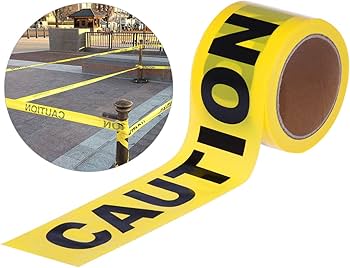Warning Tape: The Silent Guardian of Safety
introduction
Warning Tape: The Silent Guardian of Safety
Warning tape, an indispensable safety tool in daily life and work, plays a critical role in maintaining safety awareness. Its primary purpose is not just enhancing visibility and usability but delivering direct and effective alerts to address potential safety hazards. By doing so, it ensures the safety of workers and the public alike. From construction sites and chemical laboratories to traffic control zones, warning tape serves as an irreplaceable safeguard.



Effective Warning Tape: Signals, Text, and Colors for Safety
- Warning Signs: Clear Signals of Danger
One of the most common features of warning tape is its ability to convey safety information through visual warning signs. For example, yellow and black striped patterns indicate potential hazards like uneven ground or dangerous objects on the surface-frequent occurrences in industrial areas and construction sites. Statistics reveal that approximately 30% of construction site accidents stem from the lack of timely ground hazard warnings. The use of yellow and black striped patterns significantly reduces such incidents.
Similarly, red, yellow, or orange markings often denote high-risk or restricted areas. These colors are effective in capturing attention instantly, reducing the likelihood of people unintentionally entering hazardous zones. Studies show that red is the most impactful warning color, providing the strongest visual alert effect.
- Text Alerts: Simple and Clear Safety Reminders
In addition to graphic symbols, text alerts on warning tape play a crucial role. They convey specific safety messages in a concise and straightforward manner. For instance, commonly seen labels like "Toxic" or "Flammable" in laboratories provide direct descriptions, enabling workers to understand necessary precautions.
According to a study by the National Safety Council (NSC), 70% of accidents can be effectively prevented by improving visibility and safety warnings. Adding essential textual explanations to warning tape significantly mitigates such risks.
Furthermore, text designs should remain concise and easy to understand, avoiding lengthy or complex descriptions to ensure quick communication during emergencies.
- Graphic Symbols: Universal Safety Icons
With globalization, workplaces have become increasingly diverse, necessitating effective communication across cultural and linguistic barriers. Graphic symbols have emerged as a practical solution, bridging language gaps with standardized icons.
For example, red circles paired with lightning bolt symbols are widely used in construction sites or industrial zones to indicate electrical hazards. These symbols transcend language limitations, allowing individuals from various cultural backgrounds to quickly comprehend their meaning. The universal adoption of such visual language has made graphic symbols one of the most common forms of warning worldwide.
- Color Coding: Enhancing Visual Impact
Color is one of the most intuitive elements of warning tape, capable of conveying distinct safety messages. Psychological research suggests that colors not only evoke emotional responses but also influence behavior. For instance, yellow typically signals "Caution" or "Slow," while red is widely recognized as a signal for "Stop" or "Danger."
By strategically using color combinations, warning tape can draw attention effectively in complex environments, thereby improving safety alert efficacy. According to the Safety Production Report, high-contrast warning designs can enhance workers' response times to danger by over 50%. Proper use of colors can significantly improve the visual impact of safety warnings.
Material and Durability of Warning Tape

The material of warning tape directly affects its service life and performance in various environments. Different working environments have different requirements for the durability of the tape, so choosing the right material is crucial. For example, some warning tapes are waterproof, UV-resistant or heat-resistant, which allows them to maintain long-term effectiveness in extreme environments. Especially in high-risk areas such as construction sites, outdoor facilities or chemical laboratories, the use of durable tape can ensure that safety signs are not interfered with by the external environment.
In addition, reflective tape is another important choice, which plays an important role in low-light or night work. Reflective materials can improve the warning effect and help workers more clearly identify potential danger areas in dim environments. It is especially suitable for places such as traffic control or construction areas.
Application of warning tapes in different areas



Building & Construction: On construction sites, warning tapes are often used to mark hazardous areas, around equipment or working at heights, ensuring that workers are aware of potential risks and can avoid entering them by mistake. With conspicuous markings, workers can easily identify hazards and take the necessary precautions to reduce the likelihood of accidents.
Traffic management: The role of warning tapes in traffic management cannot be underestimated. Whether in road construction, accident sites or temporary traffic control areas, tape helps to clearly demarcate safe areas for travelling vehicles and pedestrians. It not only isolates dangerous areas, but also guides the flow of traffic to avoid confusion and accidents.
Chemical storage and laboratory safety: In chemical storage areas and laboratories, warning tape is often used to mark areas where hazardous substances, such as flammable and toxic substances, are stored. Through conspicuous marking, staff can clearly understand the potential hazards, so that they can take the necessary protective measures to ensure safe operation.
Public places: In public places such as shopping malls, airports and hospitals, warning tapes are often used to demarcate safe passages or prohibited areas. This not only helps to avoid confusion in the flow of people, but also effectively prevents accidents brought about by negligence. Clear warning signs make it easier for the public to recognise and follow safety guidelines, enhancing overall safety.
conclusion

Warning tape is more than just a tool-it's a guardian of safety, combining visual signals, text alerts, symbols, and color coding to keep people safe in various settings. Its ability to withstand extreme weather and low-light conditions makes it highly reliable when most needed.
Whether on construction sites, in public spaces, traffic zones, or labs, warning tape is essential for marking hazards and reducing risks. It not only protects lives but also fosters a culture of safety, promoting awareness in both work and public environments.






